Updated: 13-Feb-2020
Mr. A. Clément, a builder of first age aviation engines and the first airships made important achievements: the first really practical engines were made at the bicycle and motorcycle factory, perhaps the most important in France, known as "Cycles et Motocycles Clément".
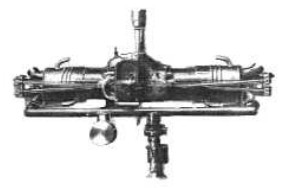
"Twin-cylinder engine"
-Between 1909 and 1912 the water-cooled, 30 CV two-cylinder was made, and mounted on the Bleriot XI and on the Demoiselle of Santos Dumont.
-This engine had double ignition, and at the rear we see the magneto including a large permanent magnet with which the magnetic circuit was closed on its rotor, constantly cutting the force lines by its rotation.
-The valve control levers are visible, and underneath, the carburetor with the intake manifold.

"Clément-Bayard on Demoiselle"

"Twin-cylinder with water supply"
-In the illustration we can see the ducts that descend from the expansion tank to the cylinder sleeves, which indicates circulation by cooling water convection.
-Later, around 1922, he also made a 7 CV, horizontal-opposed, two-cylinder and a 14 hp four-cylinder, both 2-stroke. But before and after he made many more engines.
-The upright inline engines began with the 1910 four-cylinder, until the six-cylinders like the one displayed at the Paris Olympia in 1910.
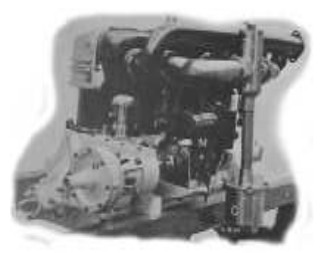
"Clement Bayard 4-cylinder"
-The water-cooled 4-cylinder engines were ranged from 40 to 220 CV. The first ones had splash lubrication.
-As a turning point they made a horizontally-fitted seven-cylinder radial engine, in 1909.
-The output power is through conical gears as we see in the diagram, and being a static radial, the cooling is with water. It has a Clerget base.

"Horizontal radial"
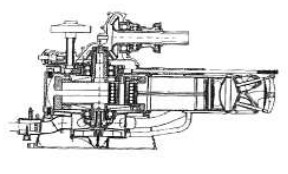
"Radial diagram"
-The evolution of the four cylinders we see in the following engines from 1910 and 1911.
-They used, like many others of the time, cylinders wrapped in red copper (cuivre rouge) sleeves that gave them a nice appearance, especially if they were kept clean and shiny.

"Clément-Bayard of 1910"
-These upright four-cylinder engines of 1910 evolved to six in 1914 with loose and paired cylinders giving 250 CV.
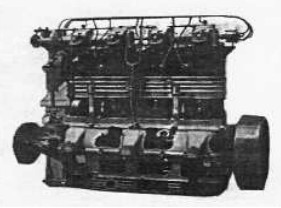
"Four-cylinder of 1911"
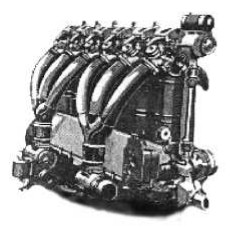
"Four-cylinder giving 250 CV"
-The inline eight-cylinders would be his contribution for postwar airships. These engines gave 300 CV.
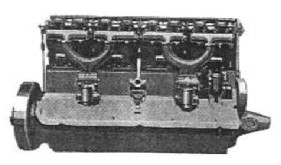
"Eight cylinder for airships"
-V-engines with 16 cylinders are known, consisting of two lines of cylinders from this 300 CV engine. (Anecdote in Clerget-Clément by "Bayard").
-Another Clément Bayard eight cylinder V with 160 CV is known as the "AM".
-This power was obtained at 1,400 rpm.
-The cylinders were twins, two by two on each side. There was a camshaft in each line, on the cylinder heads. As well as a magneto in each cylinder line.
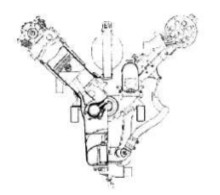
"Clément Bayard V8"
-As a curiosity, the operating manual said:
"Running the engine = On the ground, the tachometer should indicate a speed around 1,150 to 1,180 rpm; In flight, a good speed is obtained between 1,200 and 1,250 rpm.
-Never run the engine above its maximum speed regime which is at 1,400 rpm."
-We located a four cylinder Clement Bayard engine that gave 100 CV.
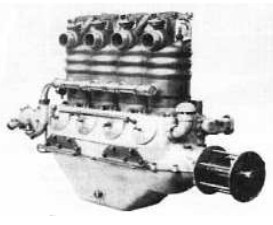
"Clement Bayard, 100 CV"

"The 1910 engine also gives 40 CV"
-The size of the photographs of these two engines are not related to their actual size.
-And an ad for the airship engine around 1910.
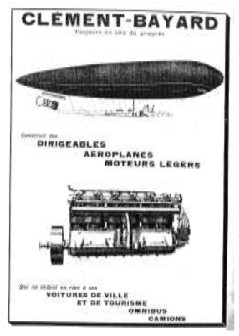
"Clement-Bayard ad"
-Another Clement-Bayard engine is the 170 CV, 6-cylinder we have obtained from an old book. It is mentioned that the engine and the clutch are mounted on a frame with springs in order to dampen vibrations.
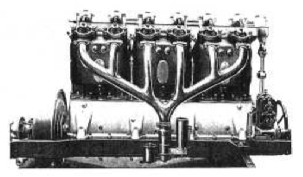
"Clement-Bayard, 170 CV"
-Another engine is the four-cylinder 200 CV that appears below. It is special for airships, weighing 500 kg.
-The pistons were 190 mm in diameter by 230 mm stroke.
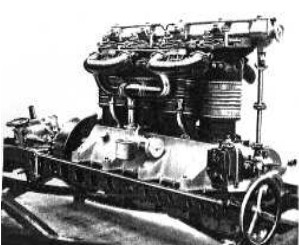
"Clement-Bayard, 200 CV"
From Appendix 7: 40 CV four-cylinder engine.

"Observe the heavy flywheel at the front"
From Appendix 9: The engine that is shown in the airship ad above in the main text has also been found in a German publication. (Vorreiter)
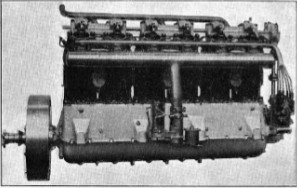
"Clement Bayard for airships, 1909"
-New illustrations of four and six-cylinder engines intended for airships.
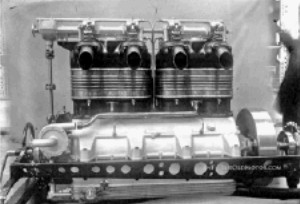
“The four-cylinder engine” (Credit. TheOldMotor)

"The six-cylinder engine" (Credit. TheOldMotor)
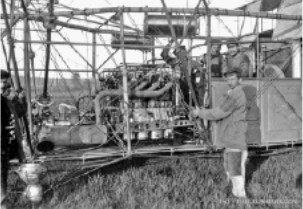
“Clement-Bayard on an airship” (Credit. TheOldMotor)
From Appendix 10: First a photograph of a 30 hp Clement Bayard twin engine weighing 50 kg, with a high power to weight ratio, more than 1.6-1.
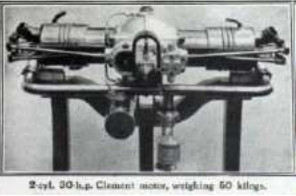
"Horizontally-opposed two-cylinder engine" (PiP)
-An assembly of two engines for the "Clement-Bayard II" airship shown below. We see that the power output transmissions for the propellers (PTO) are 45° inclined. So the propellers would be on both sides of the airship.

“125 CV engines, side by side” (PiP)
-Both engines are inserted between the structure tubes that form part of the hanging basket. Individually each engine looks like in the following picture.
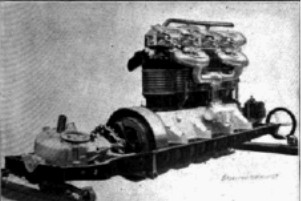
"One of the individual 125 CV engines"
-An interesting Clement-Bayard installation, certainly complicated and destined to some special machine.
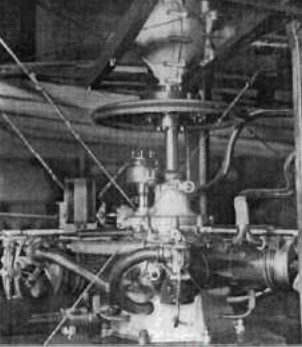
"Clement-Bayard 7-cyl. horizontal radial engine"

"Clement - Bayard boxer with lubricators"
Engines of CLÉMENT - BAYARD
Model: 16V
Arquitecture: 16-cylinder V-Engine
Cooling:
Total Displacement:
Bore / Stroke:
Power: 300 CV @ rpm
Weight:
Model: 2 twin-flat, agua 7 CV y 2T
Arquitecture: 2-stroke2-cylinder Horizontally opposed
Cooling: Liquid
Total Displacement:
Bore / Stroke:
Power: 7 CV @ rpm
Weight:
Model: 2 twin-flat, agua, 30 CV
Arquitecture: 2-cylinder Horizontally opposed
Cooling: Liquid
Total Displacement:
Bore / Stroke:
Power: @ rpm
Weight:
This engine had double ignition.
Model: 4 cils, boxer, agua, 14 CV y 2T
Arquitecture: 2-stroke4-cylinder Horizontally opposed
Cooling: Liquid
Total Displacement:
Bore / Stroke:
Power: 14 CV @ rpm
Weight:
Model: 4 cils. en linea, 40 a 250 CV
Arquitecture: 4-cylinder In-line
Cooling: Liquid
Total Displacement:
Bore / Stroke:
Power: 40 / 220 CV @ rpm
Weight:
The first ones had splash lubrication.

"Clément-Bayard, 1911 four-cylinder engine"
Model: 6 cyl. inline
Arquitecture: 6-cylinder In-line
Cooling:
Total Displacement:
Bore / Stroke:
Power: 170 CV @ rpm
Weight:
It is mentioned that the engine and the clutch are mounted on a frame with springs in order to dampen vibrations.
Model: 7 cils. radial horizontal
Arquitecture: 7-cylinder Radial
Cooling: Liquid
Total Displacement:
Bore / Stroke:
Power: @ rpm
Weight:
A horizontally positioned radial engine from the year 1909. The output power is through conical gears. It has a Clerget base.

"Clement-Bayard, horizontal radial engine"
Model: 8 cyl. inline
Arquitecture: In-line
Cooling: Liquid
Total Displacement:
Bore / Stroke:
Power: 300 CV @ rpm
Weight:
The inline eight-cylinders would be his contribution for postwar airships.
Model: 8V “AM”, 160 CV
Arquitecture: 8-cylinder V-Engine
Cooling:
Total Displacement:
Bore / Stroke:
Power: 160 CV @ 1400 rpm
Weight:
This engine is known as the "AM". The cylinders were twins, two by two on each side. There was a camshaft in each line, on the cylinder heads. As well as a magneto in each cylinder line.

"Clément-Bayard, eight-cylinder for airships"


